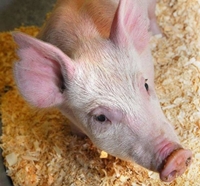After Dolly, Roslin researchers create GM-modified piglet
17 Apr 2013
 The technique is aimed at combating a fast mutating virus that affects pig herds and costs pork producers millions of pounds each year is being targeted by scientists. Also called Blue-Ear Pig Disease, the condition can prove fatal as it affects pigs' immune systems and leaves them vulnerable to other infections.(See: Pig disease that costs millions is target of genetic study)
The technique is aimed at combating a fast mutating virus that affects pig herds and costs pork producers millions of pounds each year is being targeted by scientists. Also called Blue-Ear Pig Disease, the condition can prove fatal as it affects pigs' immune systems and leaves them vulnerable to other infections.(See: Pig disease that costs millions is target of genetic study)''Gene editing'' as the technique is called is at least 10 times more efficient than existing GM technology and, crucially, does not involve the use of antibiotic-resistant genes, which has faced heavy criticism from opponents.
Researchers at the Roslin Institute in Edinburgh, where Dolly the sheep was cloned in 1996, announced yesterday that they had created the first GM pig using the technique, as part of an ambitious project to produce disease-resistant animals with genetic engineering.
The male piglet, designated "pig 26" was born last August, and had been genetically engineered with the smallest of DNA mutations - a single deletion of one out of the 3 billion chemical "letters" of its entire genome.
According to scientists the power of the new gene-editing technique was that it was extremely precise and it improved the efficiency of creating GM animals by ten-fold or more.
The technique can be carried out on fertilised eggs rather than ordinary tissue cells. It also does not need the antibiotic resistance "markers" and the elaborate cloning process that previous techniques relied on to produce GM animals.
According to professor Bruce Whitelaw of the Roslin the new production technique for producing GM animals has an efficiency of between 10 and 15 per as against an efficiency of less than 1 per cent for the standard method of genetic engineering.
One of the main arguments against the use of GM is based on the use of the genes which campaigners fear could lead to crucial drugs becoming ineffective.
According to The Telegraph, scientists looking for ways to feed the ever growing population hope it could make genetic engineering of livestock more publicly acceptable.
The process involves snipping animal DNA and inserting new genetic material.
According to researchers the technique copies a natural genetic mutation and it would therefore be impossible to tell by looking at an animal's DNA whether it had been modified.
In the case of the GM-modified piglet, the gene was taken from wild African pigs.
The creatures though naturally immune to the African fever virus cannot be bred with European species.
Researchers hope that other livestock, including cattle and sheep could be rendered to become immune against a host of other diseases with the technique.
US authorities are meanwhile, expected to grant approval to Aquabounty salmon, which has been modified to grow twice as fast as normal salmon.






.webp)















